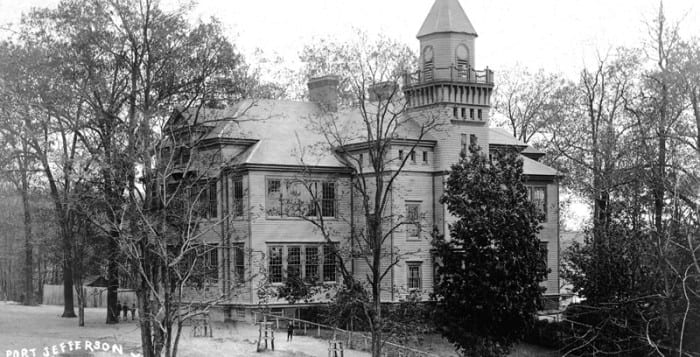
Almost no one can catch him.
This past weekend, Port Jefferson high school senior James Burke earned a silver medal at the New Balance Nationals Indoor at the Armory in Manhattan, making him the second fastest miler in the country at 4 minutes, 8.48 seconds.
It’s just one highlight of his final and most memorable indoor season.
“I’ve just been more about trying to win races and disregarding time, not really watching the clock, because my mentality with that was every record you get will eventually be broken, but every title you get can never get taken away from you,” Burke said.
Although he wasn’t watching the clock, Burke ran a new national No. 1 time in the 1,000-meter at the Molloy Stanner Games in January, finishing in 2:26.35.
Burke said the 1,000 is, of course, not his forte, but he was excited to be able to show his range.
“It was definitely a big confidence booster for me to know that there’s a variety of events that I can excel in; to know that I’m not limited to one event,” he said.
Besides topping the country, the mark also broke the Long Island record of 2:27.39, set by Chaminade’s Sean Kelly last season.
Following that race, Burke competed in the New Balance High School Boys’ Mile at the New York Road Runners’ Millrose Games in February, and finished first with a time of 4:11.25. He also nabbed his first New York State gold medal for the mile at the state championship meet earlier this month.

“Anything he had, he put it out there this year,” Port Jefferson head coach Rod Cawley said. “He performed to the best of his ability throughout the entire season, and it showed in the result.”
The medal was special to Burke not only because it was his first time earning gold in a state competition but also because of the memories that haunted him from the same meet the year prior.
Last winter, Burke made his move with about 600 meters to go in the race and was passed with nearly 20 meters left, resulting in a second-place finish.
“That image was in my head pretty much all year, because I didn’t get a chance in the spring,” Burke said, explaining that he had mononucleosis last spring and could not compete at states. “I was waiting the whole year for that day. Remembering what happened last year, every day, for the whole year, it was definitely a good feeling to place first.”
Then came the national championship, which went a little differently for the Royal compared to his previous races, but his coach was still proud of his athlete.
“He ran beautifully, he did what he had to do, he went out faster than he ever went out before,” Cawley said of his six-year varsity runner. “James persevered and he never gave up. He always tried to catch [Michigan’s Grant Fisher]. It was a phenomenal performance — very gutsy, very smart. He did a great job.”
The difference this time around was the pace of the first 800 meters. During the state meet, the first half of the race was completed in 2:17, but at nationals he finished that distance in 2:01.
The pressure didn’t bother Burke. The mile was just run differently because the stakes were high and the competition was fiercer. But as a result of the speed, Burke believes he got in his own head.

“That was the fastest I’ve ever gone through 800 meters, by 10 seconds, in the mile, so it was interesting because as I was going through it at that pace, I saw the clock and thought I should be really tired but I wasn’t,” he said. “Going through at a pace I’m just not used to going got in my head a little bit, so I told myself I was more tired than I really was.”
But Burke got through the mental minefield to secure his second-place finish.
As a result of the new feat, Burke believes that he can continue to shave time off his mile to reach his goal of four minutes.
“So much of racing is staying in the right mental place throughout the race,” he said, which is also why each time he sets foot on the track, he remains confident and determined that he will win.
Cawley said this quality is critical to his senior’s success.
“To go in to a race with that attitude gives you an advantage, because when you doubt you’re going to beat somebody, you’re not going to beat them,” he said. “James is a reality check, because with him around, no matter what you do, you just don’t look as good. He’ll always exceed your expectations and he will always perform to the best of his ability. There’s no doubt in his mind, when he stands on the track, that he’s going to beat everybody else.”






 Like two peas in a pod, Schultz and Fearon work very well together. They know their target audience well and draw the most laughs. Amanda Geraci plays Mrs. Rabbit and charms the audience with her beautiful rendition of “Morning.” Flopsy, Mopsy and Cotton-Tail, played by Marquéz Catherine Stewart, Jenna Kavaler and Caitlin Nofi (who has a fondness for Trix cereal), respectively, are a terrific supporting cast. Dan Brenner and Sue Anne Dennehy return as Mr. and Mrs. McGregor and shine in their duet, “A Friend.”
Like two peas in a pod, Schultz and Fearon work very well together. They know their target audience well and draw the most laughs. Amanda Geraci plays Mrs. Rabbit and charms the audience with her beautiful rendition of “Morning.” Flopsy, Mopsy and Cotton-Tail, played by Marquéz Catherine Stewart, Jenna Kavaler and Caitlin Nofi (who has a fondness for Trix cereal), respectively, are a terrific supporting cast. Dan Brenner and Sue Anne Dennehy return as Mr. and Mrs. McGregor and shine in their duet, “A Friend.”














